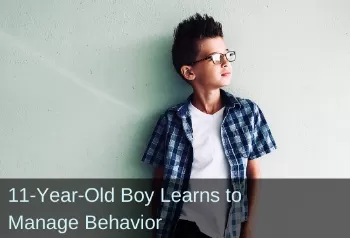Primitive Reflex Integration Case Studies
11-Year-Old Boy Learns to Manage Behavior
Rhythmic movements and Moro reflex integration help with meltdowns, food issues, and more
This preteen had daily meltdowns over normal tasks and sensory sensitivities to food. Behavior was a problem at home and at school, and he exhibited attention difficulties. By doing rhythmic movements and reflex integration from the Brain and Sensory Foundations course, his OT completely transformed all of these challenges—once his Moro reflex was integrated, the meltdowns ceased!
Submitted by Holly Keith, Master of Occupational Therapy, OTR

| Before | After |
|---|---|
| Frequent meltdowns | Calmed by rhythmic movements; no meltdowns |
| Food sensitivities | Enjoys trying new foods |
| Behavior issues | Using 5-Step Balance process to set and achieve behavior goals |
Nathan is an 11-year-old boy who has been receiving occupational therapy for the past 2 years for primarily sensory concerns (avoiding, sensitivity, and registration difficulties). I have been working with Nathan for the past 6 months and one of the first things I noticed was his Moro reflex was very much present both through stimulating the reflex and noticing behavioral concerns. The OT who was working with him before had not addressed reflexes so I was starting from square one with him with the reflex integration approach.
Nathan had frequent meltdowns, so much so that he was diagnosed as having Autism Spectrum Disorder, although myself and his other therapists disagree with this diagnosis. He also has poor attention, behavior problems at school, and behavior problems at home. Although he is not a violent child, he bit a classmate at school last year and his mother reported daily meltdowns over participating in routine tasks and sensitivities to foods. When I tested Nathan for his reflexes he presented with a retained Moro [reflex], ATNR [Asymmetrical Tonic Neck Reflex], STNR [Symmetrical Tonic Neck Reflex], and SG [Spinal Galant Reflex]. I chose to begin Nathan with innate rhythmic movements and exercises to integrate his Moro reflex [from the Brain and Sensory Foundations course].
I chose this plan because his Moro reflex was so strongly present and I wanted him to get comfortable with rhythmic movement as a strong foundation before presenting multiple reflexes to integrate. Nathan and his mom were extremely compliant with the home exercise program I provided.
While in therapy, noticeable differences were noted after Nathan participated in innate rhythmic movements. In the beginning of working on the reflex Nathan presented with high arousal levels after the exercises. His mother reported similar troubles with the exercises at home. However, as he continued to participate in them, a change was seen. He was no longer displaying levels of high arousal, but rather being calmed by the exercises. When asked how the exercises made him feel near the end of working on this reflex, he reported, “they made me feel better and they help calm me down”. Eventually the Moro reflex was integrated and his mother reports that he has not had a single meltdown since.
He also no longer has troubles with sensitivities to foods and reported, “I can now eat more new foods because now I know I like foods I thought I didn’t like before”. Through working with Nathan and his mother, I learned the importance of home exercise programs to integrate reflexes. If I hadn’t taken the time to teach Nathan and his mother how to do these exercises at home, it would have taken a lot longer to see changes as he was only coming to OT once a week.
For the 5-Step Balance, Nathan chose the goal: “I am listening to my teacher so I can hear when she asks us to clean up our lunch area and have good behavior reported for the day.” After completing the process, Nathan was able to independently come up with a really great strategy to master this goal; one better than I had thought of! The next week he excitedly reported to me that his plan worked and he did not get in trouble during lunch that week. I plan to work on Nathan’s STNR and SG reflexes next as his next area of functional concern is attention problems in school. I hope that by integrating these reflexes, Nathan will be better able to sit in his chair and focus on his work and his teacher.
(Edited, emphasis added)
*Disclaimer: The activities in the Brain and Sensory Foundations curriculum make use of the natural processes of neuroplasticity and development that are innately wired in the design of human beings to promote maturity and function. These activities appear to calm, organize, and mature the neuro-sensory-motor systems just as we see in the healthy development of human infants. Individual results may vary, and we do not claim to offer a diagnosis or cure for any specific condition or disorder. The Brain and Sensory Foundations activities appear to improve overall functioning resulting in measurable improvements for a range of conditions as demonstrated in over 1800 case studies from participants.

